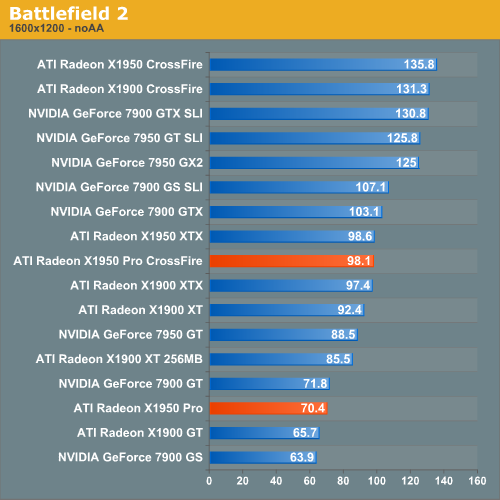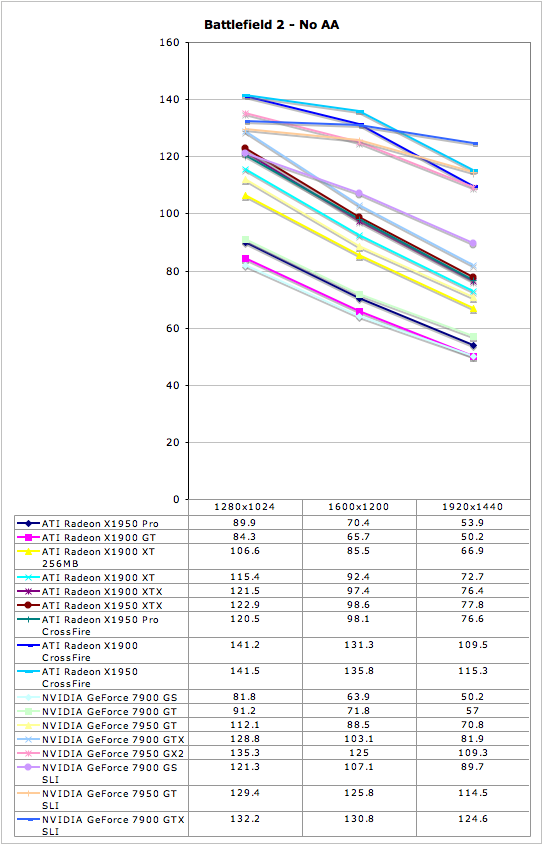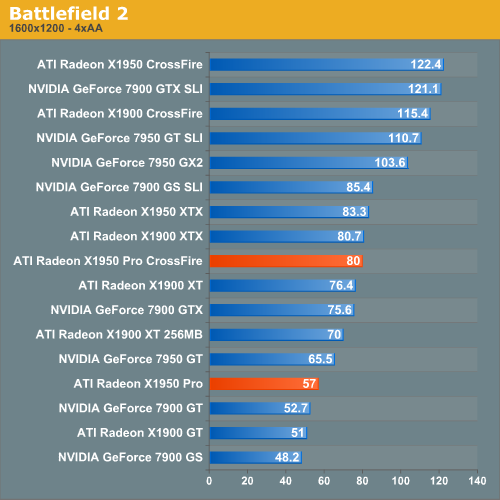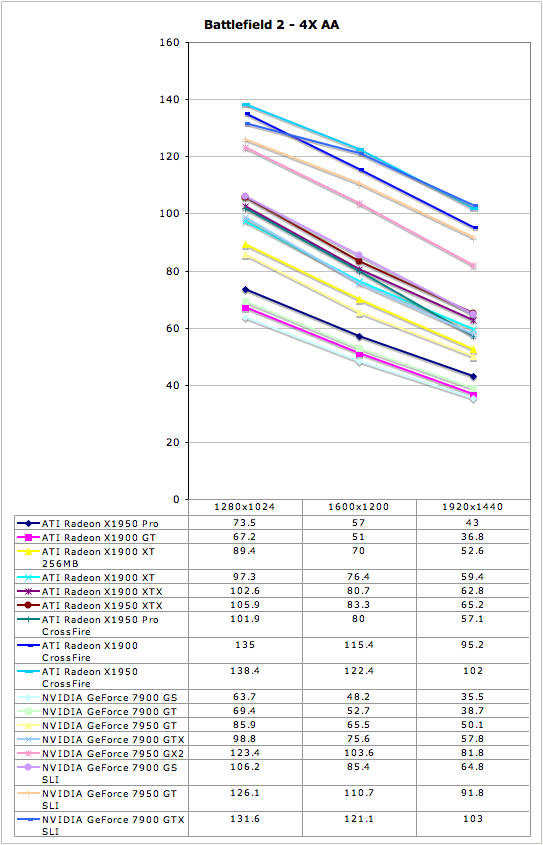ATI Radeon X1950 Pro: CrossFire Done Right
by Derek Wilson on October 17, 2006 6:22 AM EST- Posted in
- GPUs
Battlefield 2 Performance
This benchmark is performed using DICE's built in demo playback functionality
with a few added extras built in house. When using the built in demo playback
features of BF2, frames rendered during the loading screen are counted in the
benchmark. In order to get a real idea of performance, we use the
instantaneous frametime and frames per second data generated from a benchmark
run. We discard the data collected during the loading screen and calculate a
result that represents the actual gameplay that was benchmarked. While DICE
maintains that results over 100fps aren't reliable, our methods have allowed
us to get useful data from high performing systems.
During the benchmark, the camera switches between players and vehicles in
order to capture the most action possible. There is a lot of smoke and
explosions, so this is a very GPU intensive Battlefield 2 benchmark. The game
itself is best experienced with average in-game framerates of 35 and up.
We ran Battlefield 2 using the highest quality graphics settings we could.
Shadows, lighting, and especially view distance are very important in order to
best play the game. In our opinion view distance should never be set to less
than the max, but other settings can be decreased slightly if a little more
performance or a higher resolution is required.

Its ability to offer 7900 GT levels of performance at the price of a 7900 GS makes the Radeon X1950 Pro quite a deal. The added memory speed gives the X1950 Pro a good advantage over the X1900 GT here. Of course, when the new handicapped X1900 GT comes along, expect this gap to widen. X1950 Pro CrossFire offers performance levels on par with X1900/X1950 XTX under BF2 without AA enabled. This puts it in competition with the 7900 GTX and offers much better performance than the 7950 GT. All what we would expect from $400 of graphics card. Interestingly, NVIDIA's 7900 GS SLI is able to offer better performance than X1950 Pro CrossFire in spite of the single card performance advantage the later maintains. This indicates that SLI scales much better than CrossFire under these conditions.


With 4xAA enabled, the X1950 Pro performs even better compared to the competition. CrossFire, however, doesn't give any more of a boost in comparison to X1900/X1950 XTX or 7900 GS SLI than we saw without AA. The X1950 Pro is an excellent choice as a single card solution, but for multi-GPU users, SLI is still a better bet.











45 Comments
View All Comments
DerekWilson - Tuesday, October 17, 2006 - link
First of all, every site uses their own benchmarking techniques and sequences in the games. Numbers between review sites won't be comparable.For Quake 4 we used ultraquality mode, and this seems to give ATI the advantage over NVIDIA. We don't have a problem with this because we would prefer to tip the scales in favor of the product that can deliver the best performance at the highest image quality.
munky - Tuesday, October 17, 2006 - link
Would you rather Ati continued to ship the x1900gt with the original specs, and then a bunch of the cards would have to be RMA'd?DerekWilson - Tuesday, October 17, 2006 - link
We would rather they just run out of x1900 GT cards. They're discontinuing the line anyways, so it seems a little strange to try to increase supply by underhanded means.sri2000 - Tuesday, October 17, 2006 - link
They should ship it under a different model number. Call is the X1900 GTA or something like that (or some other alphabet soup combo that's not already taken) so that people can tell that the different model# = different performance.Goty - Tuesday, October 17, 2006 - link
You guys are ragging on this CF implementation like it's some sub-par solution. The transfer speed may be lower than that used by NVIDIA's SLI bridge, but SLI is simplex while this implementation is full duplex. Being able to send data in both directions at the same time should provide a huge speed boost while using ATi's SuperAA modes.JarredWalton - Tuesday, October 17, 2006 - link
Scalability is the key factory. In most benchmarks, SLI gets more of an improvement than CrossFire, indicating that the compositing engine is not an optimal multi-GPU solution. There's almost certainly a decent amount of overhead involved. We do like the new CF connector, but the proof is in the pudding. If 7900 GS is clearly slower in single card configs but often faster in dual-GPU configs, clearly SLI is scaling better than CF.mesyn191 - Friday, October 20, 2006 - link
I don't think its possible to comment on the new CF at all, they've clearly got screwed up drivers for it ATM, but then its ATi so what else is new...I hope AMD cleans up thier driver team because still even after all these years ATi does a half assed job on its drivers.
Goty - Tuesday, October 17, 2006 - link
Are you guys thinking of doing any testing with any of either vendor's multi-card AA modes any time soon? I really think the full duplex connection would really help there (i.e. the cards may not scale as well with the number of cards, but what about as the image quality increases?)Rza79 - Tuesday, October 17, 2006 - link
The Tech Report had problems with this motherboard and Crossfire which made them switch to the Asus P5W DH.You aren't expiriencing any problems with this board?
Second thing, why no AA with games like B&W2 and FEAR?
DerekWilson - Tuesday, October 17, 2006 - link
No problems with the motherboard.AA performance under Black and White 2 and FEAR were excluded because we decided framerate was already at a minimum for the resolution we were testing.